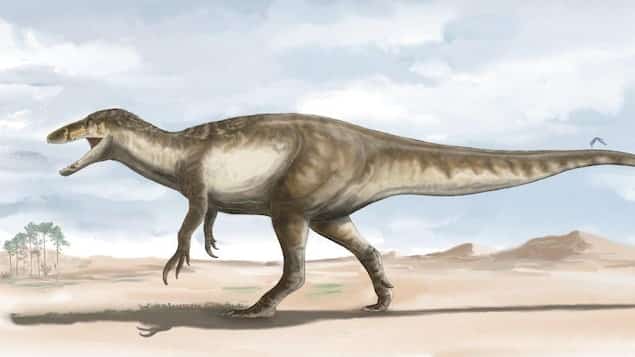Named Maip macrothoraxthe beast was between 9 and 10 meters long and weighed up to 5 tons.
The species populated the continental plains of the Gondwana supercontinent around 70 million years ago, during the Maastrichtian of the Cretaceous period.
To support this weight, its spine was made up of huge vertebrae linked together by a complex system of muscles, tendons and ligaments.
explains in a press release Alexis Aranciaga Rolando, paleontologist at the Argentine Council for Scientific Research (CONICET) and first author of the article published in the journal Scientific Reports (New window) (in English).
In addition, analysis of the bones of the Maip macrothorax helped paleontologists better understand the anatomy of these megaraptors, whose skeleton was not large and heavy like that of a tyrannosaur, for example.
” Their bones were not strong. They had a large number of internal hollows which made them much lighter, much like a hollow brick compared to a solid brick. »
Scientists believe that these animals were able to stand on their hind legs while walking or running. They also had long tails and long legs, suggesting that they were relatively agile animals.
” Their arms were long, gigantic, topped with claws up to thirty-five centimeters long, with which they captured and tore their prey to pieces. These claws were their primary weapon, as their teeth were sharp, but small. »
Better describe megaraptors
The first fossils of the megaraptor family were unearthed in 1996 in the province of Neuquén, Argentina. The discovery of Megaraptor namunhuaiquii was followed by others in Australia, Japan and Thailand.
The name Maip is borrowed from the Tehuelches who populated the region. Maip represents the shadow left by death in its wake, while we imagine that in the Cretaceous this huge predator would have caused something similar
says the paleontologist.
The term macrothoraxmeanwhile, refers to the enormous chest cavity that this dinosaur possessed.
A humid living environment
The species lived 70 million years ago in a region very different from the current Estancia La Anita, located a few kilometers from the city of El Calafate. At the time, the area was a hot ecosystem. It was a forest, almost a jungle, with pools of water, lakes, streams. Many animals lived there, including aquatic and terrestrial snails, frogs, turtles, fish, small birds and mammals
adds paleontologist Fernando Novas, who also participated in the description of the beast.
” The Andes mountain range had not yet risen. We collected the fossilized remains of all the organisms that lived at that time. Now with Maipwe have found a super predator that allows us to complete the food pyramid. »
Many parts of the skeleton have not been unearthed and therefore remain unknown, including the skull and arms.
The Argentine team plans to return to the site in 2023 to try to find other fossils there. Megaraptors are quite enigmatic predators, and although Maip has helped us elucidate many of their characteristics, including their kinship with other carnivorous dinosaurs, we still need to elucidate some aspects of their hunting behavior, including their preferred prey
explains Alexis Aranciaga Rolando.
Reference-ici.radio-canada.ca
